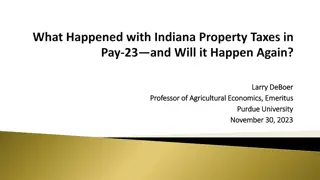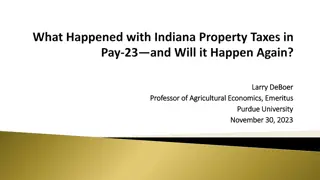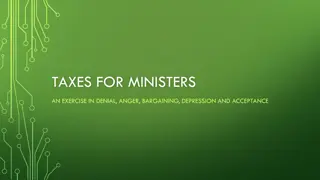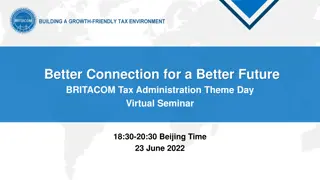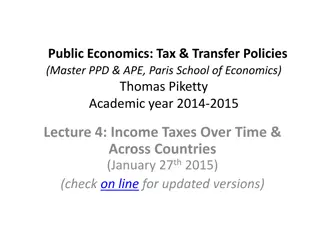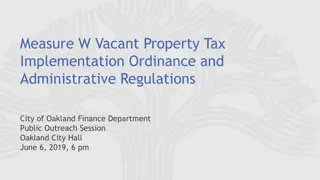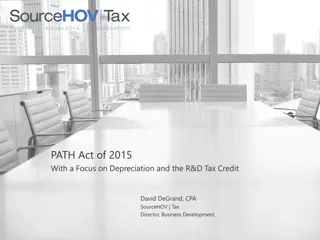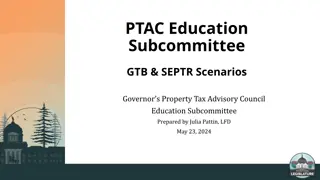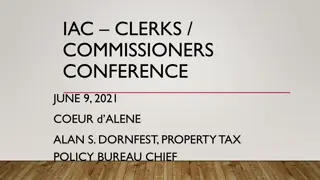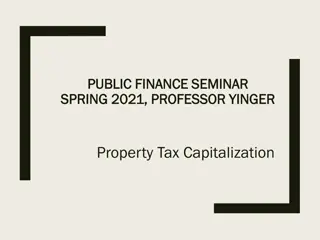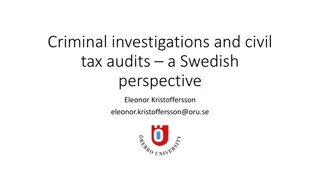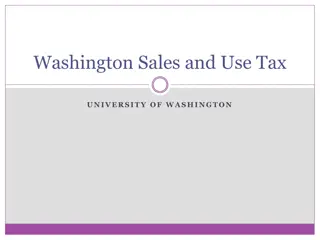Overview of Property Tax Trends and Analysis
Explore in-depth insights into property tax trends, challenges, and exemptions, with a focus on state-by-state comparisons and significant features like circuit breakers. Gain valuable information on the growth of property taxes in New England and the economic perspectives shaping state and local taxes.
Download Presentation

Please find below an Image/Link to download the presentation.
The content on the website is provided AS IS for your information and personal use only. It may not be sold, licensed, or shared on other websites without obtaining consent from the author.If you encounter any issues during the download, it is possible that the publisher has removed the file from their server.
You are allowed to download the files provided on this website for personal or commercial use, subject to the condition that they are used lawfully. All files are the property of their respective owners.
The content on the website is provided AS IS for your information and personal use only. It may not be sold, licensed, or shared on other websites without obtaining consent from the author.
E N D
Presentation Transcript
Trends in Property Taxes Lincoln Institute Seminar Economic Perspectives on State and Local Taxes May 12, 2017 Catherine Collins George Washington Institute of Public Policy
Two Objectives Depth and breadth of Significant Features 10 years of Property Tax topics for each state Interactive State by State Property Tax at a Glance Highlight Trends in Property Taxes Focusing on challenges to tax exemptions for nonprofits, particularly universities and hospitals Wider range of issues to be published in Tax Notes
Significant Features for Comparisons Circuit Breaker- Range of Eligible Income and Credit 2016 Credit Over $999 Credit $200 - $999 No Credit Maximum Minnesota New Jersey Massachusetts Vermont Connecticut - Senior Connecticut Non-senior California* Maine Maryland Nebraska New Hampshire Income Ceiling $40,000 and up Utah Wyoming District of Columbia Kansas Illinois* Pennsylvania Colorado Arizona Nevada New York Rhode Island New Mexico Oklahoma Idaho Michigan Missouri Wisconsin West Virginia Montana Iowa Income Ceiling $5,000 to $39,999 South Dakota No current state appropriation, characteristics from programs prior to cancellation are used here. Source: Significant Features of the Property Tax, special report Circuit Breakers Residential Property Tax Relief
State at a Glance State-by-State Property Tax at a Glance. http://datatoolkits.lincolninst.edu/subcenters/significant- features-property-tax/state-by-state-property-tax-at-a-glance. Significant Features of the Property Tax. Lincoln Institute of Land Policy and George Washington Institute of Public Policy. (Property Tax at a Glance; accessed: 5/3/2017 3:46:19 PM)
New England Property Tax Bouncing Back Property Tax Growth 10.0% 9.0% 8.0% 7.0% Annual Percent Change 6.0% 5.0% 4.0% 3.0% 2.0% 1.0% 0.0% 2005 2006 2007 2008 2009 2010 2011 2012 2013 2014 Growth in US Growth in New England Source: U.S. Bureau of Census Governmental Finances , selected years
Tax Base Recovering Albeit Slowly New England Total Assessed Value 2006-2016 2,000 1,900 1,800 Billions of Dollars 1,700 Assessed Value 1,600 1,500 1,400 2006 2007 2008 2009 2010 2011 2012 2013 2014 2015 2016 Source: Significant Features of the Property Tax, Tax Base by Property Type 2006-2016 https://datatoolkits.lincolninst.edu/subcenters/significant-features-property- tax/cms/CMS/ReportBuilder/Create.aspx Lincoln Institute of Land Policy and George Washington Institute of Public Policy.
For Profit Activities of Non Profits The blurring of the lines
Modern Face of Nonprofits Nonprofits are engaged in profitable activities Growth of university endowment funds and research and other income-generating activities No longer stand-alone facility rather part of complex organizations and ownership structures Need to replace declining government funding Public-private partnerships providing public services Transition from nonprofit to profit organization
Why Now Constitutional and statutory provisions Applicable statutes may be dispersed in several sections May not address complexity of current arrangements Third-party taxpayers challenge exemption as they face higher tax burden Local governments scrutinize exemptions both to avoid legal challenges and to increase tax base and revenues
Qualifications for Tax Exemption Entity organized solely or exclusively for beneficial or charitable purposes Corporation Property used for intent nonprofit purpose Property used by owner Conditions under which property is leased Revenues and profits used for charitable activities Intent of fees, charges, financial arrangements Free or sliding scale for charges Use of profits, including salaries Basis for split between exempt and taxable uses
What are the Issues Complex organizations A labyrinthine corporate structures intertwined with both non-profit and for-profit subsidiaries and unaffiliated corporate entities Must distinguish for-profit and non-profit activities and then attribute property to those activities Level and use of profits What are the funds used for Reasonable compensation or pecuniary profit Level of charity service or nonprofit-ness When is charity or community benefit enough When are fees and revenue too much
Recent Court Decisions Separate tax exemption and non-tax exempt Burden of proof on tax exempt entity to identify which properties are nonprofit (Fields, et al, v. Trustees of Princeton University, et al, New Jersey) Level of charity care [b]oth the number of uninsured patients receiving free or discounted care and the dollar value of the care they received were de minimus. (Provena Covenant Medical Center v. Department of Revenue, 925 N.E.2d 1131Illinois ) Charity work not sole factor in determining charitable status (Wexford Medical Group v. City of Cadillac, 713 N.W.2d 734 Michigan)
What Can Legislature Do Clarify definition of charity All hospital activities are exempt, BUT additional fee structure, including bed fee imposed New Jersey legislation passed, but vetoed by governor Established a test expands 3-prong test to include characteristic of a charitable organization Michigan legislation introduced 2016 SB960 Measuring charity work Charitable service exceeds property tax liability Illinois 201 Public Act 97-688 enacted constitutionality challenged Tax property that generates income above certain level Connecticut legislation introduced 2016 SB 414 Limit litigation Freeze litigation Prohibit third-party litigation
Property Tax Alternatives For non-profits or tax exempt property Payment in lieu of taxes (PILOTs) Property tax at reduced percentage Community-wide fees Right of way assessment Parcel tax
On Horizon Federal action may drive tax-exempt status Tax exemption of religious organizations with eye to the pending Supreme Court decision Impact on hospitals of Repeal and Replace or Repair of the ACA Charter schools and voucher systems Federal taxation of endowment funds
Tax Notes: Year in Review 2016 Continued expansion of relief for military and elderly as well as business personal property Restoration of some Recession-inspired cutbacks Grappling with Dark Stores with issue slowly spreading to states outside the Midwest Tax limits-expansion and impact of design interplay with state budgets Protection wetlands and dealing with extreme climate events Economic development especially increased evaluation and reporting Transparency
Catherine Collins George Washington Institute of Public Policy collins2@gwu.edu #PropTax_SFPT Significant Features of the Property Tax http://datatoolkits.lincolninst.edu/subcenter s/significant-features-property-tax/
Appendix Selected Statutes for Tax Exemptions for Nonprofits New England and Illinois, Michigan, New Jersey
Connecticut Tax Exemption [Conn. Gen. Stat. 12-81(7)(A), 12-81(16), 12-81(58), 12-88] Real and personal property held and used by a corporation organized for ..., educational, or charitable purposes exclusively for such purpose All property of any Connecticut hospital society or corporation Prohibition from any pecuniary profit from operations except reasonable compensation If portion of real property not used exclusively for such purposes, only that portion used for exempt purposes shall be exempt At local option, property leased to and used exclusively by a federal 501(C)(3) charitable, or nonprofit organization may be exempt
Massachusetts Property Tax Exemption [Mass. Gen. Laws Ch. 59, 5 (third) Real and personal property used for a , benevolent, charitable institution incorporated in Massachusetts Exemption does not apply if any income or profits of the business of the charity is used for other than the charitable purpose Must be an incorporated entity, LLC is not an adequate legal form
Maine Property Taxes [Me. Rev. Stat. Ann. Tit. 36 652] Real and personal property owned and occupied by benevolent and charitable institution and used exclusivelyfor the purposes for which it is incorporated are exempt Prohibition from any pecuniary profit from operations except reasonable compensation Portion of building owned by nonprofit corporation which was leased at full market rental value rendered the entire property subject to taxation (Lewiston v. Marcotte Congregate Housing (1996) 673 A.2d 209. ) Real property leased by nonprofit hospital is no longer exempt as of April 1, 2012
New Hampshire Property Tax Exemption [N.H. Rev. Stat. Ann. 72:23 IV, 72:23 V, 72:23 V-a] The real and personal property of colleges, academies and universities used and occupied by them exclusively for the purposes for which they are established Real property of charitable organizations used exclusively for the purposes they are established, including all profits derived from such usage For educational facilities, the value of dormitories, dining room and kitchens above $150,000 is taxable; at local option, the amount of the exemption may be increased Federal 501(c)3 status is not in itself sufficient to establish charitable status under state law
Rhode Island Property Exempt [R.I. Gen. Laws 44-3-3(a)(8)] Real and personal property owned by any corporation used for a school, academy, or seminary of learning, and of any incorporated public charitable institution and the land not exceeding one acre, so far as they are used exclusively for educational purposes No exemption is provided where any part of its income or profits, or of the business carried on there, is divided among its owners or stockholders Property, real and personal, held by a nonprofit hospital for the sick or disabled
Vermont Property Exemptions [Vt. Stat. Ann. Title 32 3802, 3831] Real property owned or leased by colleges, academies or other public schools Provided that the exemption for educational facilities shall not apply to those rented for general commercial purposes Real and personal property owned by a federally qualified health center or a free standing, federally- designated rural health clinic Provided such center or clinic is governed by a community board of directors; offers care on a sliding scale based on ability to pay; is owned and operated on a nonprofit basis; is unconditionally dedicated to public use which directly benefits an indefinite class of the public and confers a benefit on society
Illinois [35 ILCS 200/15-65, 200/15-86] A nonprofit hospital satisfies the conditions for an exemption if the value of services or activities (services that address the healthcare needs of low-income or underserved individuals) for the hospital year equals or exceeds the estimated property tax liability However, any portion that is owned by a for-profit entity shall not qualify for exemption If a parcel has both exempt and non-exempt uses, an exemption may be granted for the qualifying portion of that parcel Nonprofits providing services or facilities related to the goals of educational development All certified not-for-profit hospitals, when actively and exclusively used for beneficent and charitable purposes
Michigan Exemptions [Mich. Comp. Laws Ann. 211.7n, 211.7o, 211.9(1)(a)] Personal property of charitable, educational, and scientific institutions Real estate or personal property owned and occupied by , educational, or scientific institutions incorporated under the laws of this state with the buildings and other property thereon while occupied by them solely for the purposes for which the institutions were incorporated purpose Real or personal property owned and occupied by a nonprofit charitable institution while occupied by that nonprofit charitable institution solely for the purposes for which that nonprofit charitable institution was incorporated
New Jersey Exemption of Property of Nonprofit Organization [N.J.S.A 54:4-3.6] Real property used for educational or hospital purposes Provided that if any portion of a building is leased to profit-making organizations or otherwise used for purposes which are not themselves exempt from taxation, that portion shall be taxed Character, purpose, and activities three pronged test for exemption (Paper Mill Playhouse v. Millburn Township(1984) 95 NJ 503 472 A2d 517)
Appendix Selected Case Citations
Illinois Provena Covenant Medical Center v. Department of Revenue, 925 N.E.2d 1131 (IL 2011). Carle Foundation v. Cunningham Township, 2016 IL App (4th) 104795, 45 N.E.3d 1173 (January 5, 2016). Carle Foundation v. Cunningham Township, 2017 IL 120427 (March 23, 2017). Michigan Wexford Medical Group v. City of Cadillac, 713 N.W.2d 734 (MI 2006). Minnesota First Baptist Church of St. Paul vs. City of St. Paul, 884 N.W.2d 355 (Minn. August 24, 2016).
New Jersey Morristown Memorial Hospital v. Town of Morristown, 28 N.J. Tax 456 (2015). Fields, et al, v. Trustees of Princeton University, et al, 29 N.J. Tax 284 (2015). Red Bull Arena, Inc. v. Town. of Harrison, Dock. No. A- 1616-12T2 (N.J. App. Div. May 12, 2014). Paper Mill Playhouse v. Millburn Township 95 NJ 503 472 A2d 517 (1984). Ohio 250 Shoup Mill, L.L.C. v. Testa, 147 Ohio St. 3d 98 (2016).


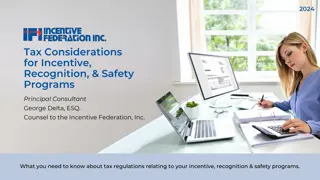
![Town of [Town Name] Real Estate Tax Rates and FY 2024 Budget Summary](/thumb/62211/town-of-town-name-real-estate-tax-rates-and-fy-2024-budget-summary.jpg)
